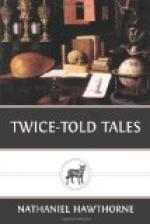Such might have been the case with Mr. Smith, when, through the brilliant medium of his glass of old Madeira, he beheld three figures entering the room. These were Fancy, who had assumed the garb and aspect of an itinerant showman, with a box of pictures on her back; and Memory, in the likeness of a clerk, with a pen behind her ear, an inkhorn at her buttonhole and a huge manuscript volume beneath her arm; and lastly, behind the other two, a person shrouded in a dusky mantle which concealed both face and form. But Mr. Smith had a shrewd idea that it was Conscience. How kind of Fancy, Memory and Conscience to visit the old gentleman just as he was beginning to imagine that the wine had neither so bright a sparkle nor so excellent a flavor as when himself and the liquor were less aged! Through the dim length of the apartment, where crimson curtains muffled the glare of sunshine and created a rich obscurity, the three guests drew near the silver-haired old man. Memory, with a finger between the leaves of her huge volume, placed herself at his right hand; Conscience, with her face still hidden in the dusky mantle, took her station on the left, so as to be next his heart; while Fancy set down her picture-box upon the table with the magnifying-glass convenient to his eye.
We can sketch merely the outlines of two or three out of the many pictures which at the pulling of a string successively peopled the box with the semblances of living scenes. One was a moonlight picture, in the background a lowly dwelling, and in front, partly shadowed by a tree, yet besprinkled with flakes of radiance, two youthful figures, male and female. The young man stood with folded arms, a haughty smile upon his lip and a gleam of triumph in his eye as he glanced downward at the kneeling girl. She was almost prostrate at his feet, evidently sinking under a weight of shame and anguish which hardly allowed her to lift her clasped hands in supplication. Her eyes she could not lift. But neither her agony, nor the lovely features on which it was depicted, nor the slender grace of the form which it convulsed, appeared to soften the obduracy of the young man. He was the personification of triumphant scorn.
Now, strange to say, as old Mr. Smith peeped through the magnifying-glass, which made the objects start out from the canvas with magical deception, he began to recognize the farmhouse, the tree and both the figures of the picture. The young man in times long past had often met his gaze within the looking-glass; the girl was the very image of his first love—his cottage-love, his Martha Burroughs. Mr. Smith was scandalized. “Oh, vile and slanderous picture!” he exclaims. “When have I triumphed over ruined innocence? Was not Martha wedded in her teens to David Tomkins, who won her girlish love and long enjoyed her affection as a wife? And ever since his death she has lived a reputable widow!”




